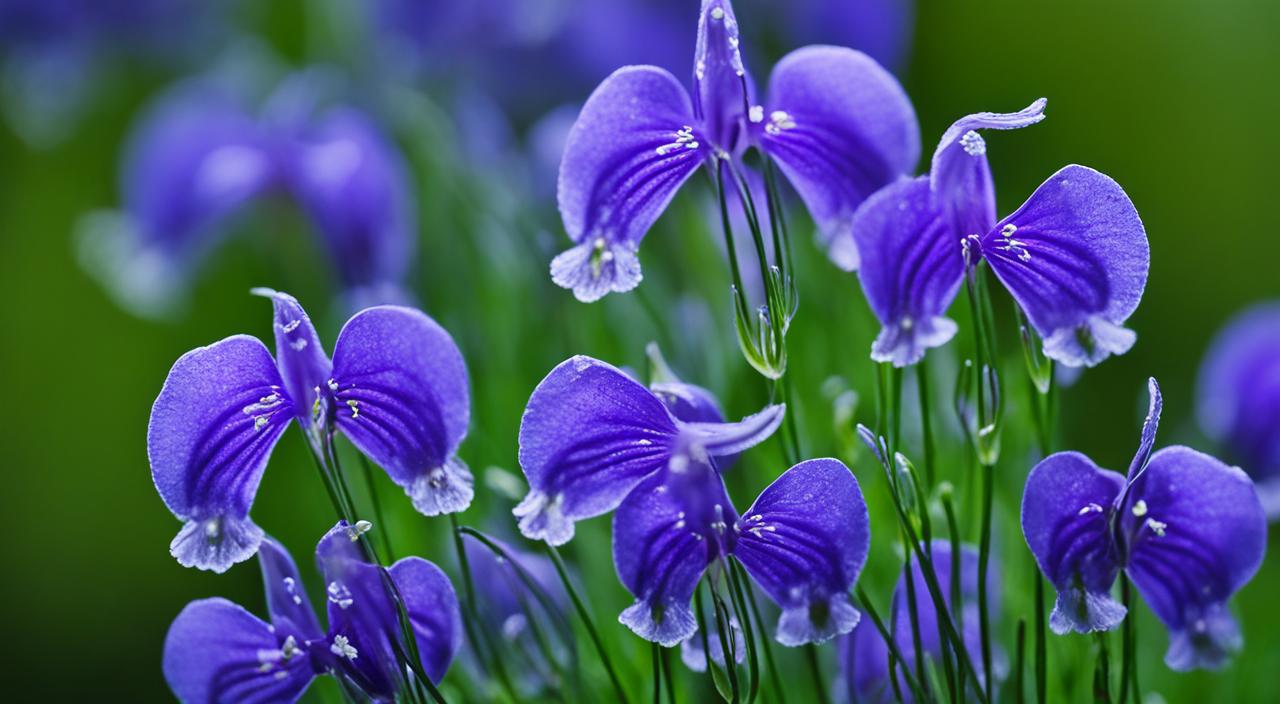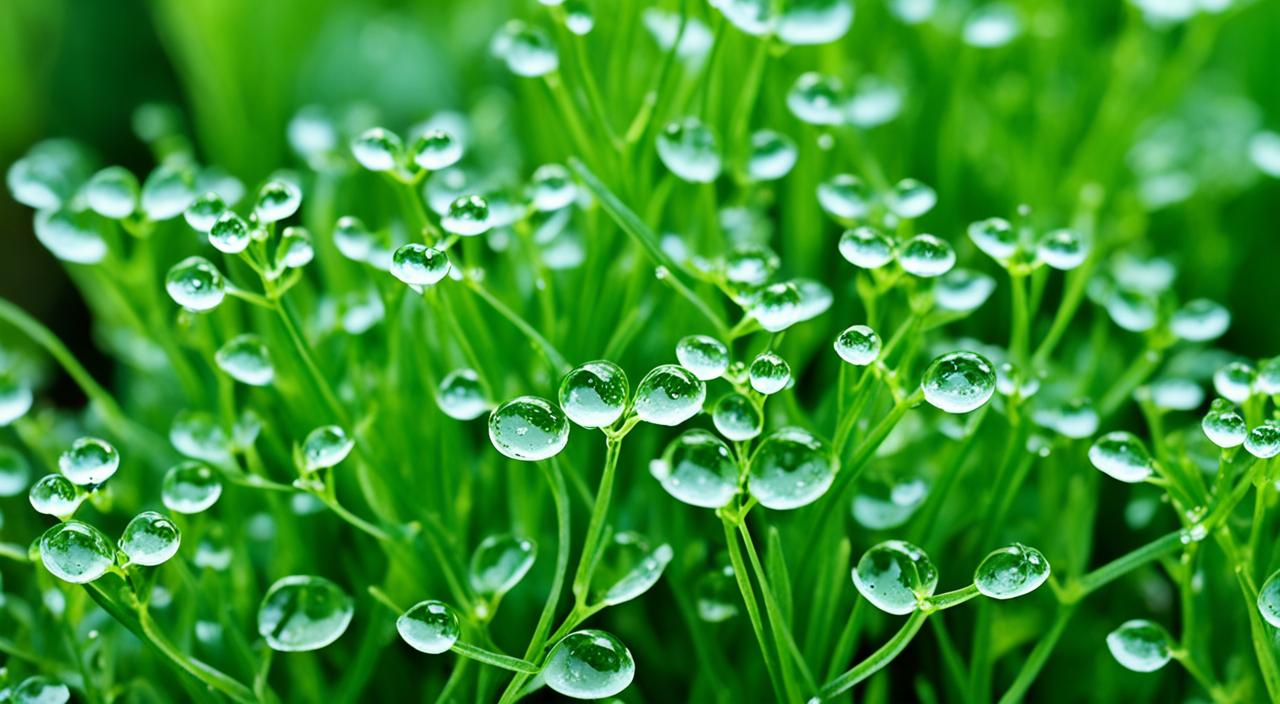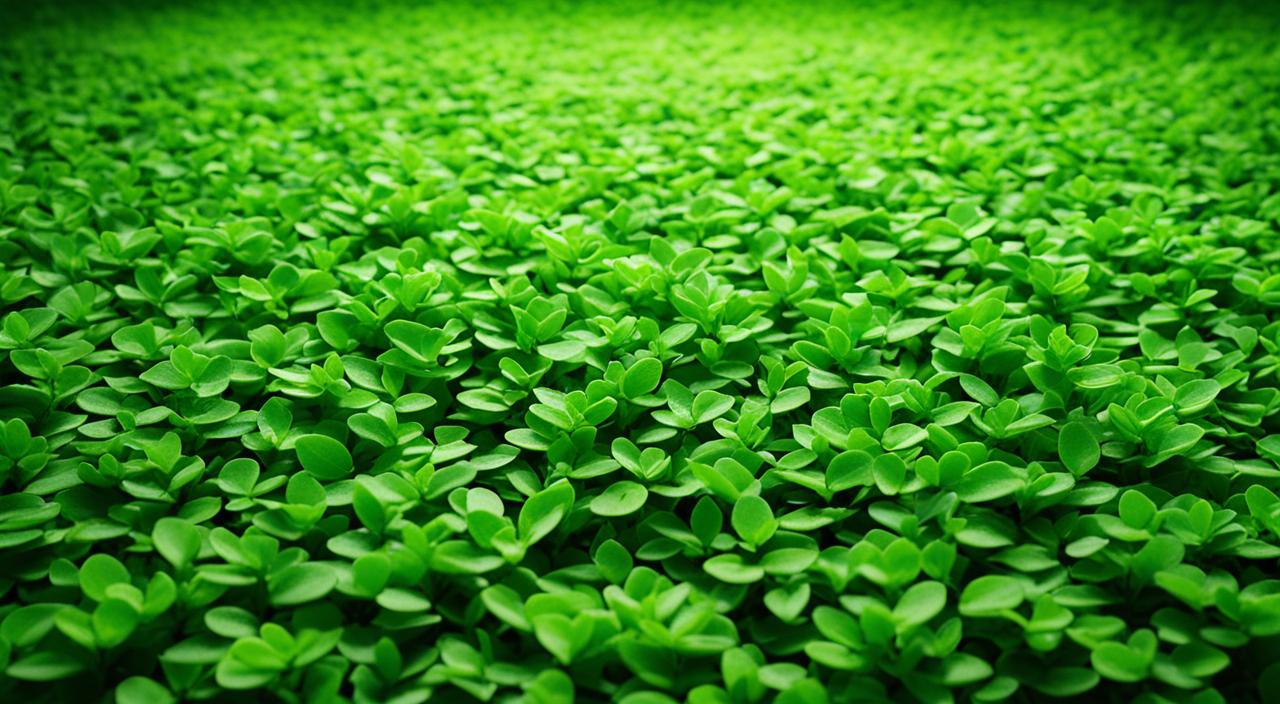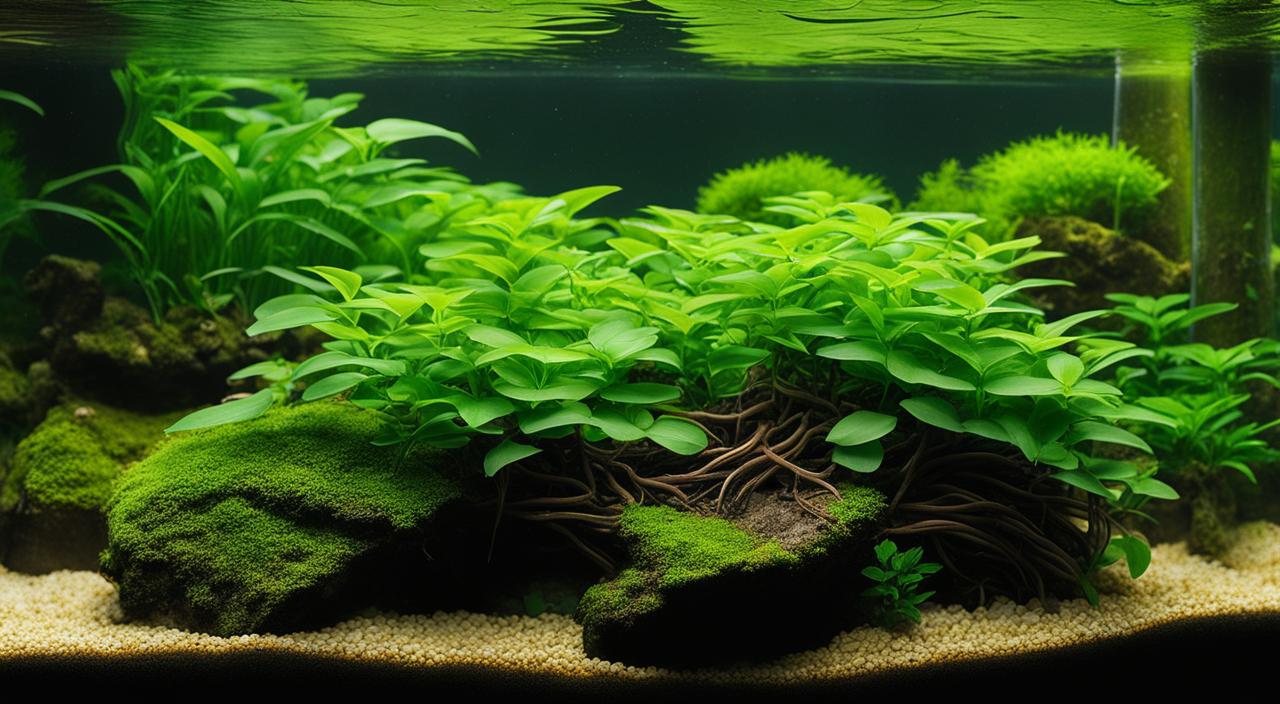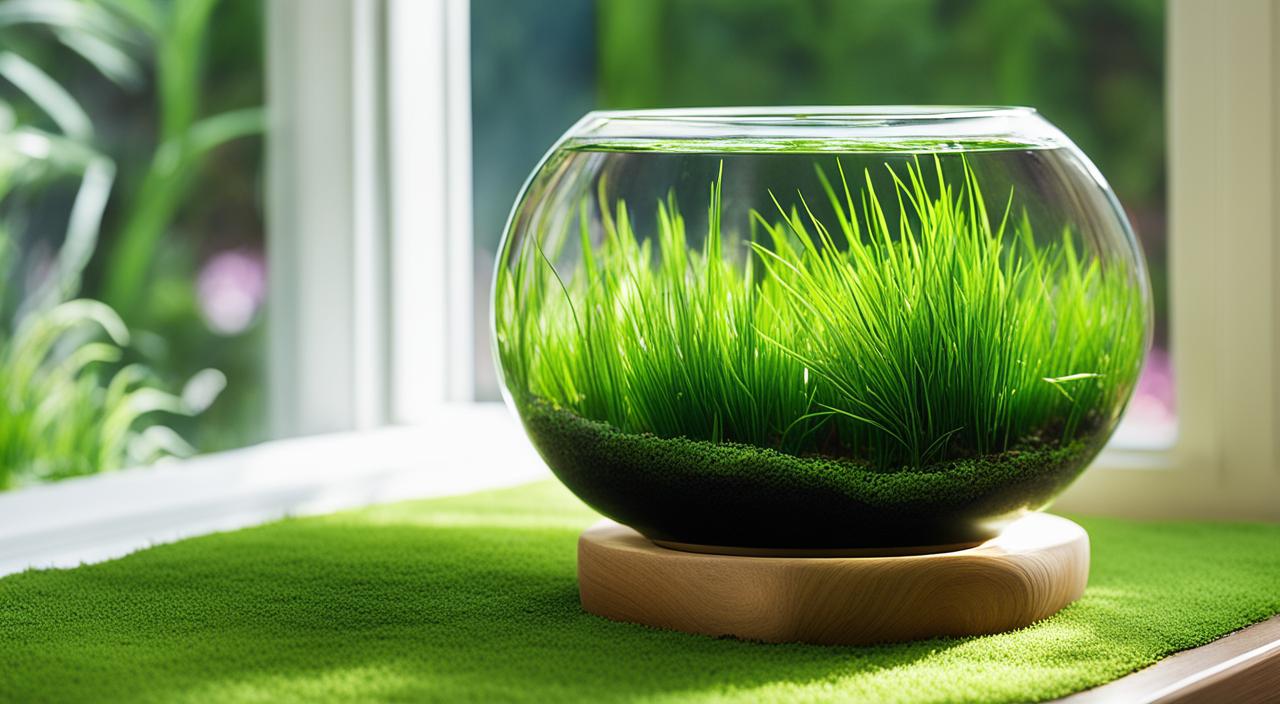Greetings! Today, I’ll share valuable insights and care tips for one of the most sought-after aquatic plants in aquascaping – Utricularia graminifolia. This small-sized plant, originating from Southeast Asia and India, has gained popularity for its remarkable ability to create lush carpets in aquariums.
Utricularia graminifolia is known for its light green foliage that forms dense mats, spreading across the substrate and hardscape. It thrives under high-light conditions, growing up to an inch in length. But don’t worry if your tank is shaded – the leaves may elongate with enough light. What makes this plant even more fascinating is its carnivorous nature – it grows tiny bladder traps that capture and digest microorganisms for nutrients.
While Utricularia graminifolia might have a reputation for being challenging to care for, it’s a highly rewarding plant once you understand its specific requirements. In this guide, I’ll provide all the necessary information to successfully cultivate and maintain the vibrant beauty of Utricularia graminifolia in your aquarium.
Key Takeaways:
- Utricularia graminifolia is a popular choice for carpeting aquarium plants in aquascaping.
- It requires high-light conditions to grow compact and maintain its carpet-like appearance.
- This carnivorous plant grows bladder traps to capture and digest microorganisms for nutrients.
- Water quality and proper aquarium set-up are essential for the health and growth of Utricularia graminifolia.
- Choosing compatible tank mates and monitoring common health issues are vital for successful care.
Brief Overview Of Utricularia graminifolia
Utricularia graminifolia is a popular choice for aquascaping due to its ability to create lush, carpeted aquarium landscapes. This aquatic plant, also known as “UG” or “Gramineous Bladderwort,” requires specific conditions to thrive and can be a rewarding addition to aquarium setups when given proper care and attention.
When planted in a mature and biologically stable tank system, Utricularia graminifolia acclimatizes slowly to its environment but can proliferate once established. While it is often seen as a challenging plant, this perception is usually due to common mistakes made in the aquarium hobby rather than inherent difficulties with the plant itself.
Utricularia Graminifolia Species Table:
| High (50-70 PAR), 5000-7000 Kelvin for optimal colour and growth, 40-70 LUX | Description |
|---|---|
| Scientific Name: | Utricularia Graminifolia |
| Common Names: | Grass Leaf Bladderwort, UG |
| Origin: | Southeast Asia |
| Height: | 2-8 cm |
| Growth Rate: | Moderate |
| Colour: | Bright green |
| Aquarium Placement: | Foreground as a carpeting plant |
| Water Type: | Freshwater |
| pH: | 5.0 – 7.0 |
| Care Level: | Moderate to High |
| Light Requirements: | Via runners or divisions of the plant |
| CO2 Requirements: | Recommended for robust growth |
| Temperature: | 22°C – 28°C (72°F – 82°F) |
| Flow Rate: | Low to Moderate (prefers gentle water movement) |
| Propagation: | Nutrient-rich substrate, CO2 supplementation, and liquid fertilizers for micronutrients are beneficial. |
| Feed Type: | Nutrient-rich substrate, CO2 supplementation, and liquid fertilizers for micronutrients are beneficial |
Origins And Habitat
Utricularia graminifolia, a captivating aquarium plant, is native to the tropical regions of Southeast Asia. Its natural habitat encompasses India, Sri Lanka, Burma, Laos, Vietnam, and southern China. This versatile plant can be found growing along the margins of springs and stream banks in the wild. Notably, Utricularia graminifolia is an amphibious plant, capable of thriving both in and out of the water.
Utricularia graminifolia prefers soft and acidic waters with a pH range of 5.0 to 6.5 in its natural environment. It is often found in nutrient-poor conditions, as it has adapted to survive in such habitats. This plant exhibits a matting habit and can form vast carpets of leaves, creating lush and visually appealing landscapes. Utricularia graminifolia thrives in dappled or low light conditions, where it can fully express its natural beauty.
Unique bladder-like structures, known as carnivorous traps, along the stolons of Utricularia graminifolia further add to its distinctive nature. These trap structures enable the plant to capture and feed on tiny aquatic organisms like infusoria, supplementing nutrient requirements in its natural environment.
Morphological Characteristics
Utricularia graminifolia is a delicate plant with light green foliage. Under solid lighting, its leaves grow to a maximum length of around one inch. If provided with insufficient light or shaded, the leaves can elongate and extend more than an inch. This plant grows tiny bladder traps along its runners, which are too small to affect even shrimp or small fish. It forms dense mats that creep across the substrate and hardscape, creating a carpet-like effect in aquariums. Utricularia graminifolia has a lighter green colour that provides a contrasting visual appeal when paired with plants with darker green tones.
Utricularia graminifolia is a delicate aquarium plant with light green foliage. It forms dense mats and grows tiny bladder traps along its runners, adding to its unique appearance. The colour of Utricularia graminifolia provides an eye-catching contrast when cultivated alongside plants with darker green tones.
Placement And Lighting
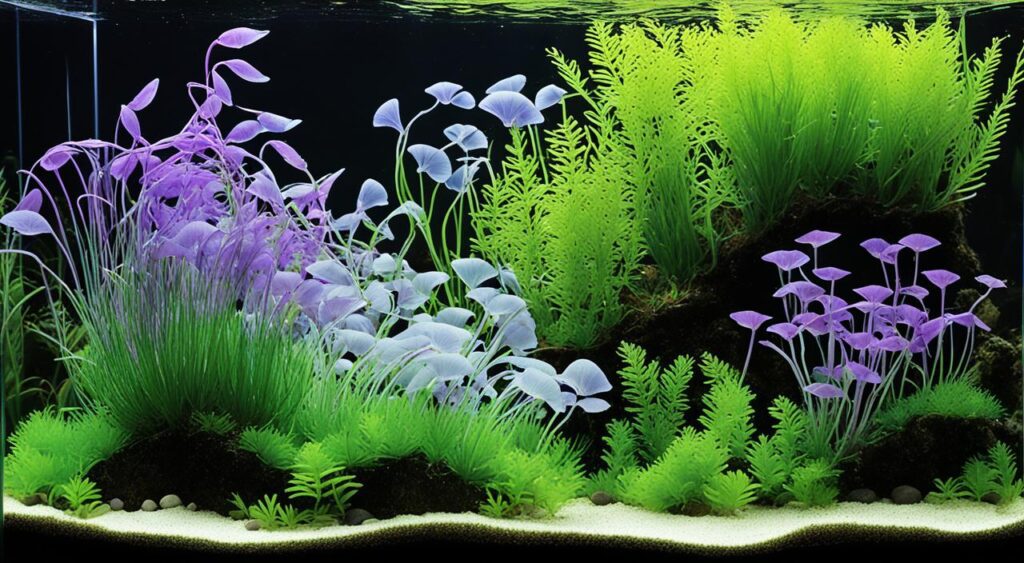
When placing Utricularia graminifolia in an aquarium, it is essential to consider its lighting requirements. This plant prefers high-light conditions to grow compact and maintain its desired carpet-like appearance. It can be placed in the foreground or midground of an aquarium, providing a different texture and visual interest. In low-tech or non-CO2 injected setups, Utricularia graminifolia can be grown as a floating plant, as long as there is not excessive flow. However, to achieve a dense and healthy carpet, carbon dioxide injection is recommended. Poor lighting conditions or overcrowding can lead to elongated leaves, affecting the plant’s overall aesthetic.
What Are Good Tank Mates?
Utricularia graminifolia, a delicate and visually appealing aquarium plant, can thrive alongside various aquatic species. Choosing suitable companions is crucial to ensure the well-being of both the plant and the tank mates. When selecting tank mates for Utricularia graminifolia, it is crucial to consider their behaviour and compatibility with this delicate plant.
Good Tank Mates
Several small and peaceful fish species make compatible tank mates for Utricularia graminifolia. Some examples include neon tetras (Paracheirodon innesi), rasboras (Boraras spp.), and guppies (Poecilia reticulata). These species coexist harmoniously with Utricularia graminifolia, adding liveliness and colour to the aquarium without causing damage to the delicate plant.
Fish Species To Avoid
Avoiding fish species known for uprooting or disturbing plants when keeping Utricularia graminifolia is essential. Certain cichlids and larger herbivorous fish, such as some goldfish species (Carassius auratus), should be avoided as tank mates. Their feeding habits and behaviour can damage the delicate structure of Utricularia graminifolia’s runners and leaves, hindering its growth and aesthetic appeal.
| Good Tank Mates | Fish Species To Avoid |
|---|---|
|
|
Feeding (Fertilization)
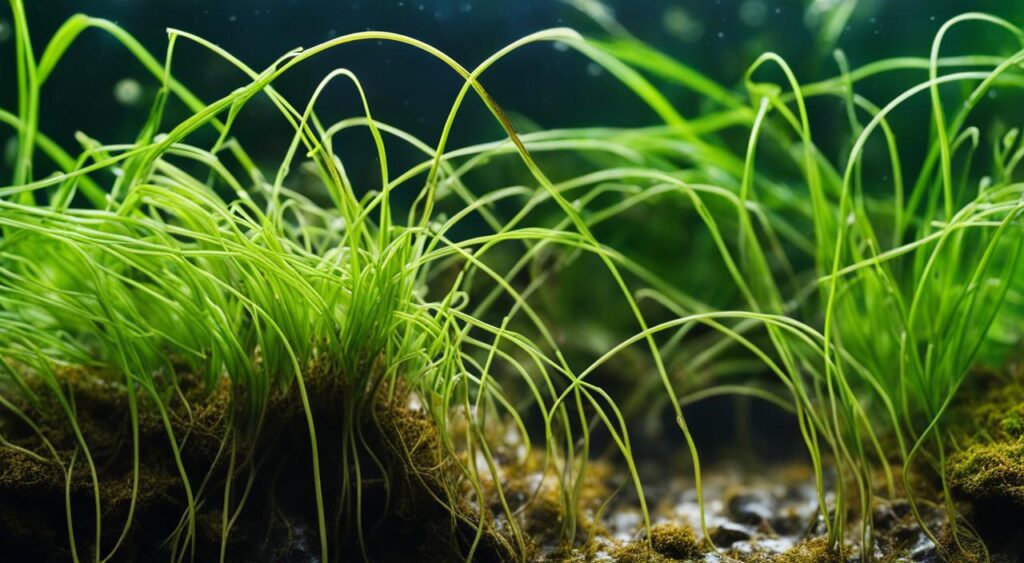
Utricularia graminifolia is a fascinating plant that uses its carnivorous nature to acquire nutrients. Its tiny bladder traps capture small microorganisms, providing the plant essential sustenance. As a result, Utricularia graminifolia does not require additional fertilizers to thrive.
However, offering a diet of living infusoria can enhance the growth and propagation rates of Utricularia graminifolia. Feeding live infusoria sparingly can supplement the plant’s natural nutrient acquisition process and ensure optimal development.
There is no specific feeding schedule for Utricularia graminifolia since it predominantly relies on its carnivorous adaptation for sustenance. The plant can obtain sufficient nutrients from the captured microorganisms, eliminating the need for regular fertilization.
How Much And How Often To Feed
When deciding on the quantity and frequency of feeding for Utricularia graminifolia, it’s crucial to strike a balance. While the plant benefits from the supplementary feeding of infusoria, offering too much food can cause an imbalance in the tank’s ecosystem.
I recommend starting with small amounts of live infusoria and observing the plant’s response. A weekly or bi-weekly feeding may provide additional nutrients without overwhelming the plant or affecting the water quality. Monitor the health and growth of the Utricularia graminifolia closely to determine the ideal feeding frequency for your specific aquarium setup.
Remember that each tank is unique, so considering the aquarium’s overall condition, the presence of other plant species, and the behaviour of tank inhabitants is crucial when establishing a feeding routine for Utricularia graminifolia.
CO2 Injection
CO2 injection is crucial for optimizing the growth and acclimatization of Utricularia graminifolia in the aquarium. By supplementing carbon dioxide, the plant receives an additional source of carbon, which is essential for photosynthesis and overall plant health.
Several methods are available for CO2 injection in aquariums, allowing aquarists to choose the most suitable option based on their preferences, budget, and experience level. Some common types of CO2 supplementation methods include:
- Compressed CO2 Systems involve pressurized CO2 gas released into the aquarium through a diffuser. They provide precise control over CO2 levels and are often considered the most effective method for promoting plant growth.
- Liquid Carbon Supplements: Liquid carbon supplements, such as liquid CO2 products, contain organic compounds that release carbon dioxide when added to the aquarium. While they are less potent than compressed CO2 systems, they can still provide beneficial carbon supplementation.
- DIY Yeast-Based Setups: DIY yeast-based setups utilize a mixture of sugar and yeast to produce carbon dioxide through fermentation. This homemade approach offers a cost-effective alternative, particularly for hobbyists on a budget.
Regardless of the chosen method, it is vital to monitor and adjust CO2 levels in the aquarium consistently. Fluctuations in CO2 concentrations can adversely affect the growth of Utricularia graminifolia and upset the CO2 balance in the tank, which may lead to algae growth or hinder plant development.
Implementing a reliable CO2 injection strategy can significantly enhance the health and vitality of Utricularia graminifolia, ensuring its successful cultivation in the aquarium ecosystem.
Care
Proper care is essential for the successful cultivation of Utricularia graminifolia in aquariums. Planting this species in a matured and biologically stable tank system is recommended, allowing it to acclimate gradually to the environment.
Planted Tank Parameters
When caring for Utricularia graminifolia, providing the optimal parameters in a planted tank is crucial. This includes providing appropriate lighting, CO2 injection, and nutrient levels. The plant thrives in high-light conditions, so ensure that you have solid and consistent lighting throughout the day. CO2 injection is also recommended to promote healthy growth and carpeting. Maintaining balanced nutrient levels supports the plant’s overall health and development.
Water Quality
Utricularia graminifolia prefers nutrient-poor, soft, and acidic water conditions. Aim for a pH range of 5.0 to 6.5 to create an ideal environment for the plant. Regularly test the water quality to ensure it meets these parameters and make any necessary adjustments. Keeping the water clean and free from contaminants is crucial for the health and longevity of Utricularia graminifolia.
Filtration
Choosing the right filtration system for your aquarium is essential when caring for Utricularia graminifolia. The filtration system should be sufficient to maintain water clarity without creating excessive flow that can uproot or damage the delicate plant. Consider using a canister or sponge filter to provide adequate filtration without causing too much disturbance to the plant.
Flow
Adequate water circulation is necessary for Utricularia graminifolia to thrive. It helps to distribute nutrients evenly throughout the aquarium and prevents stagnant areas that can lead to the buildup of debris and algae. Ensure sufficient water flow in the tank, but avoid strong currents that can harm the delicate plant. Positioning the filter outlets strategically and using a water pump can help achieve the ideal water flow for Utricularia graminifolia.
Aquarium Maintenance
Proper maintenance is crucial for the health and longevity of Utricularia graminifolia in aquariums. Regular water condition testing ensures the plant is thriving within its preferred parameters. Monitoring pH, ammonia, nitrite, nitrate, and other nutrient levels helps maintain a balanced and suitable plant growth environment.
Testing Water Conditions
Regular water testing is essential to ensure the optimal growth of Utricularia graminifolia. You can identify any imbalances or fluctuations that may adversely affect the plant by monitoring key parameters such as pH, ammonia, nitrite, and nitrate levels. Testing kits or meters are available to measure these parameters accurately. Aim to keep the water within the recommended range for Utricularia graminifolia, maintaining a slightly acidic pH of 5.0 to 6.5.
How To Set Up Your Aquarium Tank
Proper installation of your aquarium tank is crucial for the successful growth of Utricularia graminifolia. Start by choosing suitable substrate and hardscape materials that provide the right conditions for the plant’s root system to anchor and spread. Ensure that the lighting setup is appropriate for Utricularia graminifolia, providing the high light levels required for compact growth. Additionally, carefully select a filtration system that maintains water clarity without creating excessive flow that may disturb the delicate plant.
Propagation Methods
Propagation is an exciting way to expand your Utricularia graminifolia collection or share it with other aquarists. This plant can be propagated through two main methods: dividing rhizome mats or propagating from seeds. Dividing the rhizome mats involves carefully separating sections of the plant and replanting them in suitable aquarium areas. Propagation from seeds requires patience and attention to detail, as the seeds are tiny and delicate. Follow specific instructions for each propagation method to ensure the best chances of success.
Health And Disease
Monitoring the health of Utricularia graminifolia is essential to prevent and address any issues that may arise. By understanding the indicators of a healthy plant and recognizing signs of poor health, aquarists can take appropriate measures to ensure the well-being of their Utricularia graminifolia.
Signs Of Good Health
Indicators of a thriving Utricularia graminifolia include vibrant green leaves, compact growth, and active trapping of microorganisms in its bladder traps. When the plant is healthy, the leaves maintain their bright green colour, demonstrating solid photosynthetic activity. Compact growth indicates that the plant is spreading and forming a lush carpet, a desired characteristic of Utricularia graminifolia.
Signs Of Poor Health
Signs of a struggling Utricularia graminifolia may include yellowing or browning leaves, stunted growth, and deterioration of the bladder traps. Yellowing or browning leaves indicate nutrient deficiencies or excesses, negatively impacting the plant’s health. Stunted growth may result from insufficient light, nutrition, or other environmental factors. Deterioration of the bladder traps may signify the plant’s inability to capture and digest microorganisms, which can indicate poor nutrient uptake.
Common Health Issues And Treatment
Utricularia graminifolia can encounter specific health issues, including algae growth, nutrient deficiencies or excesses, and melting. Algae growth can be managed through appropriate lighting, maintaining optimal nutrient levels, and promoting healthy plant growth to outcompete the algae. Nutrient deficiencies or excesses can be addressed by adjusting fertilization and monitoring water quality. Melting, characterized by the deterioration of the plant’s leaves and stems, may be caused by sudden changes in environmental conditions or nutrient imbalances, and addressing the underlying causes is crucial for recovery.
Plant Pests
Common pests affecting Utricularia graminifolia include snails and aphids. Snails can damage the plant by feeding on the leaves and roots, while aphids can hinder its growth by sucking sap from the plant tissues. Employing appropriate pest control measures, such as manual removal of snails or applying natural predators, can help manage these pests and protect the health of Utricularia graminifolia.
| Health Issues | Treatment |
|---|---|
| Algae growth | Optimize lighting, nutrient levels, and promote healthy plant growth. |
| Nutrient deficiencies or excesses | Adjust fertilization and monitor water quality. |
| Melting | Identify and address underlying causes, such as sudden environmental changes or nutrient imbalances. |
| Snails | Manually remove snails or introduce natural predators. |
| Aphids | Employ appropriate pest control measures to manage aphid populations. |
Summary
In summary, Utricularia graminifolia is a captivating and versatile aquarium plant that hails from the enchanting regions of Southeast Asia and India. This plant can create mesmerizing carpeted landscapes within aquariums, adding a touch of natural beauty to any aquatic environment. However, it is essential to note that Utricularia graminifolia requires specific care and conditions to thrive and flourish.
When caring for Utricularia graminifolia, providing it with high-light conditions is crucial, as this is essential for maintaining its distinctive carpet-like appearance. CO2 injection is highly recommended to ensure optimal growth and overall health. Alongside these factors, careful consideration must be given to selecting suitable tank mates that will not disrupt the delicate structure of this plant.
It is worth highlighting that Utricularia graminifolia is a carnivorous plant, utilizing tiny bladder traps to capture and digest microorganisms for nutrients. This unique feeding adaptation differentiates it from other aquarium plants, making it a captivating addition to any aquatic setup. To ensure the longevity and well-being of Utricularia graminifolia, consistent care, maintenance, and diligent monitoring of water parameters are essential.
By adhering to the recommended guidelines, aquarium enthusiasts can fully appreciate the remarkable beauty and distinct characteristics Utricularia graminifolia brings to their aquascaping endeavours. With its lush carpeting and striking foliage, Utricularia graminifolia has the power to transform aquariums into breathtaking underwater landscapes that are sure to captivate the senses.
FAQ
What is Utricularia graminifolia?
Utricularia graminifolia is a small-sized aquarium plant that originates from Southeast Asia and India. It is known for its ability to form dense carpet-like mats in aquariums.
How can I care for Utricularia graminifolia?
Proper care for Utricularia graminifolia includes providing high light conditions, CO2 supplementation, and ensuring suitable tank mates. It is also important to monitor water parameters and maintain water quality.
Where does Utricularia graminifolia originate from?
Utricularia graminifolia is native to Southeast Asia, including countries like India, Sri Lanka, Burma, Laos, Vietnam, and southern China.
What are the physical characteristics of Utricularia graminifolia?
Utricularia graminifolia has light green foliage that grows up to an inch in length under strong light. It also grows bladder traps along its runners, which are used to catch microorganisms for nutrients.
What are the lighting requirements for Utricularia graminifolia?
Utricularia graminifolia prefers high light conditions to grow compact and maintain its carpet-like appearance. Carbon dioxide supplementation is recommended for optimal growth.
What are suitable tank mates for Utricularia graminifolia?
Good tank mates for Utricularia graminifolia include small and peaceful fish like neon tetras, rasboras, or guppies. It is important to avoid fish species that may uproot or damage the delicate plant.
Does Utricularia graminifolia require additional fertilization?
While Utricularia graminifolia can obtain nutrients from its carnivorous traps, providing a diet of living infusoria can benefit its growth. Feeding can be done sparingly as a supplement.
How can I provide CO2 supplementation for Utricularia graminifolia?
CO2 injection, such as compressed CO2 systems or liquid carbon supplements, can greatly benefit the growth and acclimatization of Utricularia graminifolia. Consistent monitoring and adjustment of CO2 levels are necessary.
What care is needed for Utricularia graminifolia?
Proper care for Utricularia graminifolia includes planting it in a mature and biologically stable tank system, maintaining appropriate water conditions, and routine aquarium maintenance. Propagation can be done through division or seeds.
How do I monitor the health of Utricularia graminifolia?
Monitoring the health of Utricularia graminifolia involves observing its appearance and growth. Signs of good health include vibrant green leaves and active trapping of microorganisms. Common health issues and plant pests should be addressed promptly.
What are some common health issues for Utricularia graminifolia?
Common health issues for Utricularia graminifolia include algae growth, nutrient deficiencies or excesses, and melting. These issues should be treated accordingly to prevent further damage.
Can Utricularia graminifolia be propagated?
Yes, Utricularia graminifolia can be propagated through division of rhizome mats or by propagating from seeds. Careful handling is necessary to prevent damage to the delicate plant.
What are the key points about Utricularia graminifolia?
Utricularia graminifolia is a small-sized aquarium plant that forms dense carpet-like mats. It requires high light conditions, CO2 supplementation, and suitable tank mates. Proper care, monitoring water parameters, and routine maintenance ensure its health and longevity.

